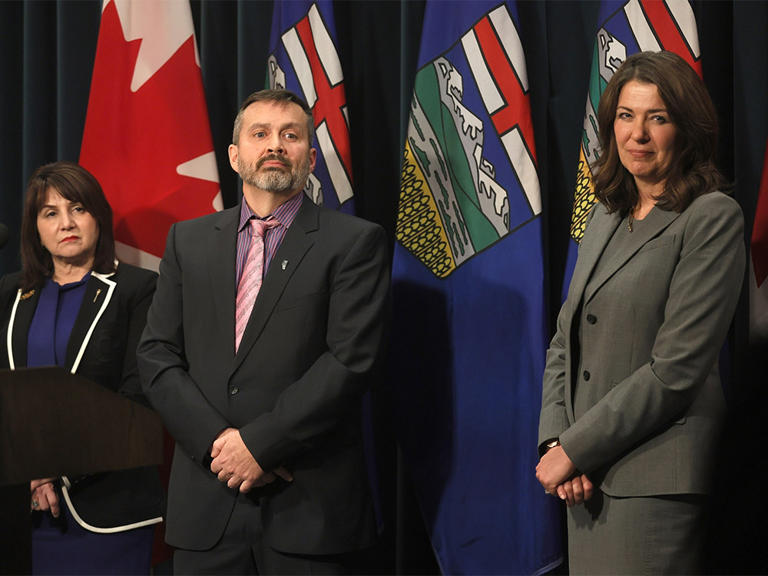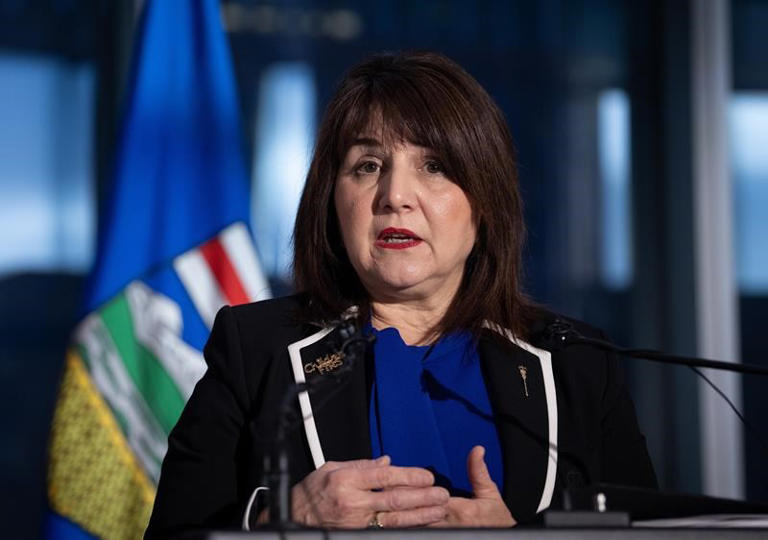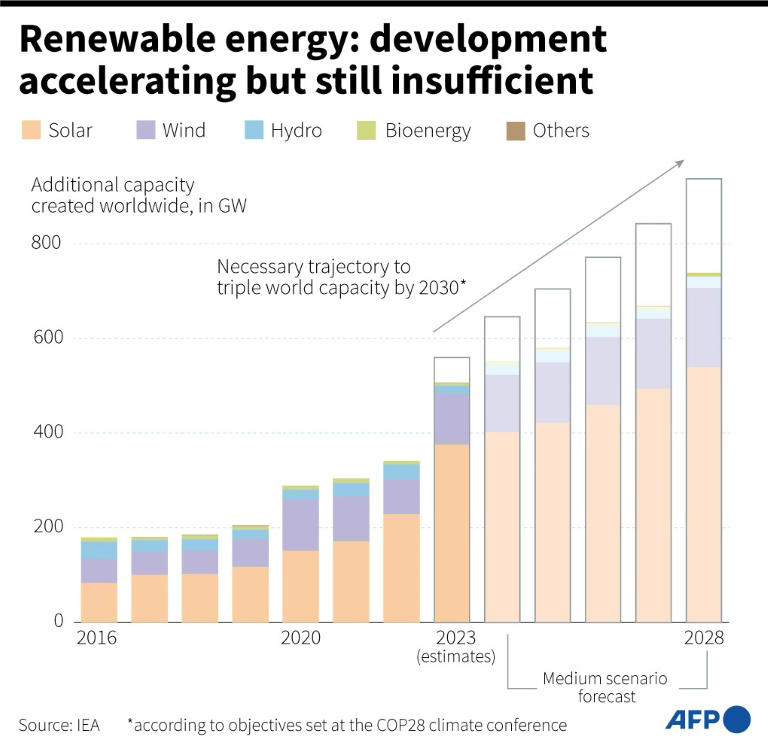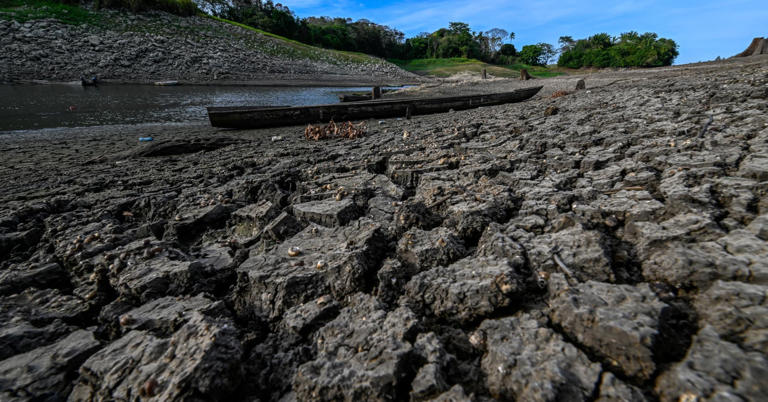Bell: Top Alberta doc to Danielle Smith — 'We don't need more chaos'
Opinion by Rick Bell •

Health Minister Adriana LaGrange, Dr. Paul Parks and Premier Danielle Smith provided an update on the status of ongoing joint work to stabilize primary health care in Alberta at the McDougall Centre in Calgary on Thursday, December 21, 2023.© Provided by Calgary Sun
Dr. Paul Parks, the Alberta Medical Association president, is in the trenches this day in the emergency room in Medicine Hat and he’s busy.
When he finally has a minute your scribbler wants to know what he has to say about Premier Danielle Smith’s latest comments on the state of health care in Alberta.
Over the holidays, eyeballs sizzled over Smith’s words, no matter the political stripe of the reader.
The premier was not holding back. She saw layers and layers and layers of middle managers at Alberta Health Services and saw a problem.
She saw some managers not solving the problems in the delivery of health care.
She saw people wanting more dough for more than a decade to improve care, getting the cash and then care decreasing.
She said her health minister, Adriana LaGrange, will tour the province’s hospitals, go to the front lines and listen to the workers, find the problems and fire the managers who haven’t been solving those problems.
Smith is not afraid to use the word “fire.”
The premier said she’d seen page after page of managers, 40 pages in Edmonton zone alone.
AHS managers who hadn’t seen the eyeballs of patients in a number of years will have to “pick up their game” and “demonstrate their value.”
For Smith there were bosses and bureaucrats preventing front-line workers from helping people, leaving those workers to deal with a worsening situation.
Smith went on to say she gave managers a year to make some progress and they started moving in that direction but then after the election last year they started back-sliding.
Dr. Parks agrees it is critical to do things differently.
He says if you polled docs about whether they thought something major had to change in AHS operations, 70% or 80% would fully agree.
But Parks adds some of the reason the system “is still going, even though we’re on the brink of collapse, is because we have some amazing people in AHS really keeping the ship afloat in an unbelievably difficult situation.”
“The system is really, truly being stressed. It’s so fragile,” says Parks.
Bell: Danielle Smith to Alberta Health Services managers — shape up or ship out
'As bad as we’ve seen it in 25 years': AMA president sounds alarm as Alberta hospital wait times rise
Alberta Medical Association hopeful AHS overhaul is better for doctors and patients
Alberta breaking up AHS, creating new agencies in health care overhaul
What he hears is the idea of “looking for heads to roll” leads to no managers wanting to “be creative and stick their neck out or pop their head up enough so they’re a target.”
This “paralyzes a lot of key decision makers.”
So, on the one hand, Parks agrees something needs to be shaken up.
“But on the other side, now in a climate where you have the premier saying heads are going to roll do you think there are going to be many in management jumping up and down and making themselves targets even if they have really good ideas?”
Parks says many in the system have frustrations but …
“You can’t just go in and chop off a whole bunch of heads without a real, solid concrete plan as to what you’re going to do to replace them or enable new leaders to fill the void.
“If you’re going to go in and shake up the system then have a plan to replace it when the dust settles.
“We don’t need more chaos.”
Decisions can’t be made and announced with the details left hanging in uncertainty.

Dr. Paul Parks at the McDougall Centre in Calgary on Thursday, December 21, 2023.
Parks urges a sit-down with himself and the new AHS boss and the highest level of the government’s health ministry, among others, to hammer out “an evidence-based and expert-informed plan” to make big changes.
The Alberta Medical Association president wants to make sure two things are crystal clear.
“There are some really good managers who are very constrained by the way Alberta Health Services operates and the way the system currently exists,” says Parks.
“Breaking that logjam and freeing them up to really make local decisions and be creative and really think differently is exactly the goal we share and we want.”
But … there is a but when it comes to finding the good people.
“But coming in with a guillotine and heads will roll is going to make it hard to identify who those people are,” says Parks.
We will see where this goes.
Remember the premier won the leadership of the UCP vowing to fight the Liberal government in Ottawa while, with equal passion, slamming those running the health-care system during the COVID pandemic.
When Smith was asked if what she’s talking about would end up being a big deal her answer is one word.
“Exactly.”
rbell@postmedia.com

© Provided by The Canadian Press
EDMONTON — The new president of emergency medicine for the Alberta Medical Association says ER physicians already coping with long hours, staff shortages and jammed waiting rooms are also being obligated, in some cases, to work for free.
Dr. Warren Thirsk says Premier Danielle Smith’s government has yet to follow through on a promise to reimburse emergency room doctors for so-called "good faith" payments.
"There's been lots of excuses, but the bottom line is no one has actually received a penny for those suspended good-faith payments," Thirsk said in an interview.
"On average, every emergency physician in this province is out thousands of dollars for free work."
Good-faith payments reimburse ER doctors when they see patients who don’t have identification and can’t prove an Alberta Health Care Insurance Plan billing number.
Thirsk said the United Conservative government stopped those payments when it ripped up the master agreement with the AMA in early 2020. He said it promised to bring back those payments when the two sides agreed to a new deal in September 2022.
But to date that hasn’t happened, he said.
"I'm legally and morally bound to look after you (if) you’re unidentified (as a patient)," said Thirsk, an emergency room doctor at Edmonton’s Royal Alexandra Hospital.
"(And) I’m going to look after you because it’s the right thing to do no matter what the problem is."
He said ER doctors are paid per patient, and the amount also depends on the diagnosis.
"When the contract was signed (in 2022), one of the conditions was they were going to fix the good faith (payments) right away," said Thirsk.
“And then they found red tape.
“Even now we haven't been paid for good-faith billings.”
Andrea Smith, spokesperson for Health Minister Adriana LaGrange, said the province remains committed to reinstating the good-faith payments.
"Alberta Health has been working on system updates to allow for retroactive payments and this policy is expected to be implemented in the near future," said Smith in a statement.
Provincewide delivery of medical care is handled through Alberta Health Services, with an annual budget close to $17 billion.
AHS, in a memo to staff made public this week, said it is forecasting a budget deficit and is seeking 10 per cent cuts to overtime and outside service delivery to help balance the bottom line.
Alberta, like other jurisdictions, is facing long waits for care and overcrowding in emergency wards.
Thirsk, an emergency room doctor for 25 years, said the problems are founded in a system that views health workers as costs rather than investments.
He said emergency doctors are routinely asked to cover off vacancies and shortages in other jurisdictions, particularly at the hospital in Red Deer.
"It's become a regular thing. We probably get once a month an AHS email asking us to cover a shortfall in Medicine Hat, in Lethbridge, in different cities," he said.
"I think that all the emergency departments across the province are stressed out and are just overcapacity. And I think that that's unfortunately the new situation normal.
"There's probably very few emergency physicians who haven't seen a patient seriously harmed or even die from the gaps in the system, and it's frustrated all of us. There's nowhere to take this."
Asked about the general sentiment he hears from ER colleagues, Thirsk replied: “They want out. Everyone wants out. People are desperate to get out. (They ask) 'How can I get out? What else can I do? This isn't fun anymore.' Those are the quotes I hear right now.”
He said he has little faith a massive restructuring of Alberta Health Services will solve the problem.
This year, Smith’s government aims to dismantle Alberta Health Services to create four agencies linked to specific areas of care — such as acute care and primary care — all answering to LaGrange and cabinet.
Thirsk said the province is creating silos in what needs to be an interdependent system linked to patients rather than specialties.
“As a front-line worker who has no resources to look after the patients in front of me and is apologizing for that every day, I find it incredibly frustrating that we will drop $80 million into an administrative reshuffle,” he said.
“Giving four silos just means you’ve got four different ways to say, 'It’s their problem, not mine.'
“We're on the Titanic, and we're rearranging the proverbial deck chairs.”
This report by The Canadian Press was first published Jan. 11, 2024
Dean Bennett, The Canadian Press
EDMONTON — Alberta’s Opposition says it’s time to dump once and for all the remaining bottles of imported Turkish children’s fever medicine, given new reports state the liquid clogs hospital feeding tubes and can put newborns at risk of severe illness.
NDP health critic Luanne Metz says Premier Danielle Smith’s government should check with health specialists to see if the medicine can safely be put to use somewhere else in the world but says regardless it's time to end the experiment in Alberta.
“We really should not be using this in our emergency departments,” Metz, who is also a physician, said Wednesday in an interview.
“It's certainly not preferred for a parent, who would get rid of it for sure, and we definitely should not be using it in (feeding) tubes.
“So where might there be a place that this would be a preferred treatment? I can't see it.
“We probably should get rid of it.”
Metz made the comments in light of a Globe and Mail newspaper report published earlier Wednesday.
The story, citing internal government documents, illuminated concerns the imported Turkish acetaminophen, with its higher viscosity, risked clogging feeding tubes for fragile patients.
Also, with its comparatively lower dosage and higher volumes, it put newborns at risk for necrotizing enterocolitis, which can cause damage to their intestines.
Alberta Health Services, in a statement Wednesday, confirmed the acetaminophen, known under the brand name Parol, was banned in neonatal intensive care units last spring and was used for only two months in total before hospitals reverted to the regularly used medicines.
Related video: Alberta's immunization campaign raising questions (Global News)Duration 2:15 View on Watch
“No patients, including infants requiring neonatal intensive care, were injured or fell ill as a result of its use,” said AHS in the unsigned statement.
The medicine was part of a deal Alberta signed with Istanbul-based Atabay Pharmaceuticals for five million bottles of Parol and the ibuprofen known as Pedifen.
Smith herself announced the purchase at a news conference in late 2022, promising to alleviate a domestic shortage of children’s fever medication.
The purchase was immediately beset by delays as the province sought regulatory approval from Health Canada and sorted out packaging and warning labels.
By the time most of the first shipment of 1.5 million bottles had arrived in the spring of 2023, the domestic fever medication shortage was over.
The rest of the shipment never arrived.
Of those 1.5 million bottles, only about 9,000 were sent to hospitals and 4,700 to pharmacies in what critics have labelled a $75-million boondoggle, with taxpayers out tens of millions.
As soon as the medicine arrived, there were concerns that the comparatively lower dosage concentration of the Turkish medicine increased the risk of dosage errors. Pharmacists had to keep the medicine behind the counter to make sure customers who bought it were aware of the dosage change.
By the summer of 2023, AHS had already advised staff to switch back to the pre-existing medicines. However, last fall Health Minister Adriana LaGrange said Parol and Pedifen were not on the scrap heap, but would be kept in reserve for future emergencies.
LaGrange, asked Wednesday in an email if the Turkish medication could still be used in an emergency, declined to answer.
Instead she directed questions to Alberta Health Services.
AHS, in its statement, also declined to confirm the future of the two medicines while referring to them in the past tense.
“The additional supply of children’s pain medication provided assurance, long-term, for our stock of acetaminophen in AHS facilities at a time of a global shortage and high demand,” it said.
The clock is already ticking on the remaining supply. The Pedifen is set to expire in November 2025 and the Parol two months after that.
LaGrange, in her statement, reiterated past comments that the province bought the medicine with the best of intentions.
“We acted out of compassion and concern at a time when you could not find children’s medication on the shelves,” LaGrange wrote.
This report by The Canadian Press was first published Jan. 10, 2024.
Dean Bennett, The Canadian Press

 Global News
Global News






